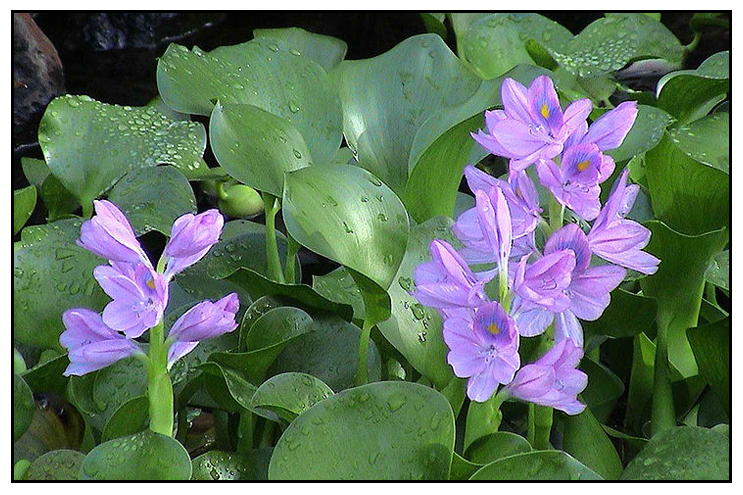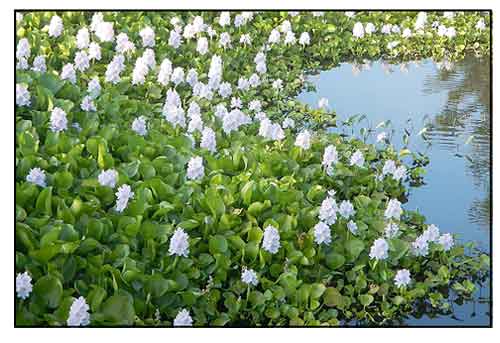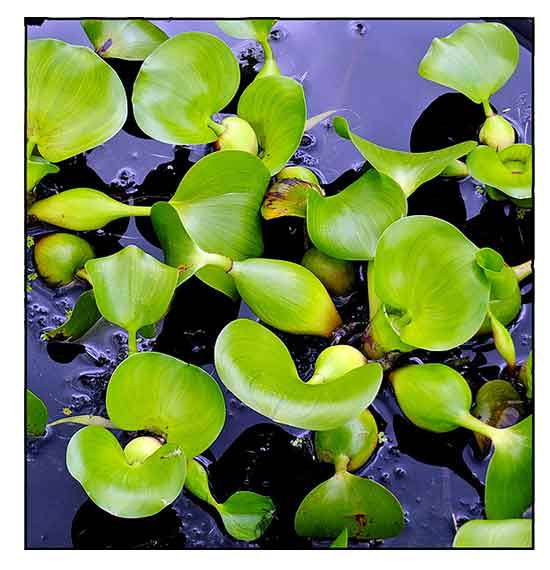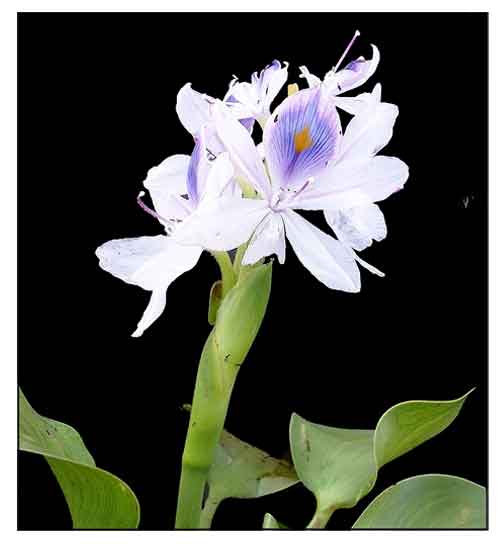 Gen Info Gen Info
- Pontederiaceae is a family of flowering plants, placed in the order Commelinales, in the commelinid clade, in the monocots. The family contains two genera with about 40 known species. It is best known for the water hyacinth (Pontederia crassipes), an invasive species in many waterways.
-
Etymology: The genus Pontederia was named by Linnaeus in honor of Italian botanist Giulio Pontedera. The species name derives from Latin crassus (thick, fat) and pes (a foot), referring to the swollen petioles.
- Considered as one of the world's most productive plants, and also one of the top ten's most noxious and invasive aquatic weeds.
- Anecdotally, it is known as the "Bengal terror" due to its invasive growth tendencies. It has been referred to as the "beautiful blue devil." (48) Also called "German weed" in Bangladesh on the belief that the German Kaiser submarine mission was involved in introducing it at the outbreak of World War I. Water hyacinths were also called "Japanese trouble" in Sri Lanka on the rumor that the British planted them to entice Japanese aircraft to land on insecure pads. (49)
- The weed forms dense monocultures that can threaten local native species diversity and alter the aquatic environment, altering the ecosystem structure and disrupting the food chains and nutrient cycling. (36)
Botany
• Eichhornia crassipes is a floating and clump-forming aquatic herb with long roots and runners. Leaves form a rosette, shiny, obovate to almost rounded, with the petiole inflated like a bladder. Flowers are borne on long spikes, each spike with numerous stalkless, hyacinth-like flowers. Flowers are large, with six showy sepals, pale lilac, up to 4 centimeters long. Top sepal has a central yellow diamond shaped area surrounded by a blue border. Fruit is an ovoid capsule.
 • A free-floating, aquatic plant typically reaching up to 0.3 - 0.65 m, but occasionally up to 1 m. Roots: Fibrous roots are long and feathery. Foliage: Large, roundish leaves are slightly cupped, smooth and glossy with entire leaf margin. The ball-shaped leaf stalk at the base of the leaf is filled with spongy tissue that helps to keep the plant afloat. Stems: Water Hyacinth produces stolons, underwater stems that connect the parent plant to its genetically identical progeny. Flowers: Light purple to blue flowers are arranged on a spike inflorescence. The top petal has a yellow, oval-shaped center surrounded by distinct, dark purple lines that originate from the base, radiate outwards and branch toward the middle and outer edges of the petal. The inflorescence perched on a long stalk can reach up to 0.6 m tall. Fruit: Fruit is a capsule that contains 3 compartments filled with small, ribbed seeds. (49) • A free-floating, aquatic plant typically reaching up to 0.3 - 0.65 m, but occasionally up to 1 m. Roots: Fibrous roots are long and feathery. Foliage: Large, roundish leaves are slightly cupped, smooth and glossy with entire leaf margin. The ball-shaped leaf stalk at the base of the leaf is filled with spongy tissue that helps to keep the plant afloat. Stems: Water Hyacinth produces stolons, underwater stems that connect the parent plant to its genetically identical progeny. Flowers: Light purple to blue flowers are arranged on a spike inflorescence. The top petal has a yellow, oval-shaped center surrounded by distinct, dark purple lines that originate from the base, radiate outwards and branch toward the middle and outer edges of the petal. The inflorescence perched on a long stalk can reach up to 0.6 m tall. Fruit: Fruit is a capsule that contains 3 compartments filled with small, ribbed seeds. (49)
Distribution
- Naturalized.
-
Introduced to the Philippines around 1912 as an ornamental, now an ubiquitous weed clogging water courses, ponds, and lakes all over the country.
- Occasionally planted in ponds or aquaria as an ornamental.
- Native to Argentina Northeast, Argentina Northwest, Bolivia, Brazil North, Brazil Northeast, Brazil South, Brazil Southeast, Brazil West-Central, Chile Central, Colombia, French Guiana, Guyana, Paraguay, Peru, Suriname, Uruguay, Venezuela. (12)
- Now almost pantropic.
- In many places, a noxious and invasive aquatic weed.
Constituents
- Fresh plant yielded alkaloids, flavonoids, phenols, sterols, terpenoids, anthroquinones, and protein. (See study below) (3)
-
Chloroform extract yielded anthocyanins, phenolics, proteins and carbohydrates; an ethanol extract yielded metabolites such as flavonoids, anthroquinones, phenolics and carbohydrates. (see study below) (13)
 - Fractionated extracts
yielded the presence of phenols, protein, alkaloids, amino acids, carbohydrate, flavonoids, glycosides, tannins, and terpenoids. (see study below) - Fractionated extracts
yielded the presence of phenols, protein, alkaloids, amino acids, carbohydrate, flavonoids, glycosides, tannins, and terpenoids. (see study below)
(16)
- Nutritive analysis of samples from different places showed no significant variation. Study (g/100 g DM) yielded dry matter (8.7-9.8), crude protein (10.1-11.2),
crude fiber (26.1-27.4), ash (12.3-12.4), and metabolizable energy (1999.7-2054.1 Kcal/kg). (27)
- Study of various extracts of fresh shoots and rhizomes by thin layer chromatography using different solvent systems yielded 11 amino acids, seven essential AA and four non-essential AA, viz., serine, valine, leucine, methionine, aspartic acid, glutamic acid, lysine, tyrosine, tryptophan, histidine, and isoleucine, respectively. (37)
- Waterhyacinth possesses nutritional important compounds viz., phenolics, flavonoids, glutathione and many other metabolites.
Phytochemical screening yielded alkaloids, flavonoids, tannins, terpenoids, anthraquinones, phenols, quinones, glycosides, reducing sugar, and steroids, with absence of saponins, sterols, carbohydrates, and proteins. (see study below) (40)
Properties
- Considered styptic.
- Studies suggest
antibacterial, antioxidant, antifungal, hepatoprotective, nematicidal, anticancer, anti-inflammatory, anti-tumor, phytoremediative, larvicidal, wound healing properties.
Parts used
Shoots, leaves, juice.
 Uses Uses
Edibility
- Young leaves and leafstalks are edible.
- In Java, green parts, inflorescences and flowers spikes are cooked and eaten. (15)
Folkloric
- No recorded folkloric medicinal use in the Philippines.
- In Chhattisgarh, used as styptic. Fresh juice of weed used to treat fresh wounds to stop the spread of infection. With vinegar, used for treatment of septic wounds. In folklore medicine, used to relieve swelling, burning, hemorrhage, and goiter. (2)
- In Tamil Nadu, India, flower oil applied daily treatment of skin diseases. (26)
- In Assam, India, flowers and roots used for stomach ache; roots used in the treatment of pneumonia. (30)
- In Bangladesh, roots and flowers used in the treatment of hepatic disorders and pandu (abdominal swelling on one side). Crushed roots taken with honey for hepatic disorders. Flowers are cooked and eaten as vegetable for pandu. (34)
- In Nigeria, plant used for skin care. (35)
Others
- Veterinary: Used a tonic for skin of horses, for irritation and inflammation. (2)
- Biomass: An excellent source of biomass. Polluted hyacinths can be converted to natural gas methane, albeit, at present, a costly process. Also, has potential use as fertilizer and as wastewater treatment. (15) It can be used as compost, paper, fuel. In East Africa, used in making furniture, hand bags, and ropes. (•) Study demonstrated the efficacy of water hyacinth use as compost and handicraft and as new source of income for the Alaotra region of Madagascar. (37)
- Fodder: Nutritive analysis suggests E. crassipes has potential as feed for livestock during scarcity periods. (see constituent above) (27)
Studies
• Acute Toxicity Study: Study evaluated the acute oral toxicity of various plant extracts in Swiss mice. Studies were carried out based on OECD guidelines. The highest dose administered, 2000 mg/kbw, did not produce mortality of changes in general behavior of the test animals. Results indicate safety of ethyl acetate, aqueous extract and methanol fractionate of aqueous extract of Eichhornia crassipes. (1)
• Anti-Inflammatory / Shoots and Leaves: Study evaluated various solvent extracts of EC for anti-inflammatory activity on formaldehyde induced paw edema in male Swiss albino mice. Results showed all tested extracts of leaves and shoot portion possess anti-inflammatory activity. (2)
• Phytochemicals / Antimicrobial: Study of extracts and fractionates of fresh Eichhornia crassipes showed significant and remarkable activity against two bacteria (Micrococcus luteus and Rhodospirillum rubrum) and two fungi (Monoscus ruber and Aspergillus fumigatus. Phytochemical screening of fresh plant yielded alkaloids, flavonoids, phenols, sterols, terpenoids, anthroquinones, and protein. (3) Study of solvent extracts was tested against Staphylococcus albus and fungal strains Mucor sp. An acetone extract showed better activity against the microbes. (see constituents above) (13)
• Antifungal and Anti-Algal: Study of crude methanolic extract and its fractions showed inhibition of Candida albicans. Some anti-algal activity was seen against green microalgae, Chlorella vulgaris and Dictyochloropsis spendida, as well as cyanobacteria, Spirulina platensis and Nostoc piscinale. An alkaloid and four phthalate derivatives was presumed responsible for the antimicrobial and antialgal activities. (4)
• Antibacterial and Antifungal: Study of various extracts showed the ethanolic hot extract showed antibacterial and antifungal activity. Major components in the extracts were saponins, polyoses, alkaloid salts, and reducing compounds. Results show the devastating aquatic weed, with its strong antimicrobial potentials and biologically active phytochemicals, may be useful for developing alternative compounds to treat infectious diseases. (5) Crude extract and fractions of Eichhornia crassipes showed moderate activities against Gram positive and Gram negative bacteria, with 50% potency of tetracycline. Extracts and fractions showed antifungal activity only against Candida albicans. (26)
• Antitumor on In-Vivo Induced-Melanoma: Water hyacinth is considered by some to be the world's worse aquatic plant, presenting a severe environmental and economic problems in all gulf coast states and many other parts of the world. Study screened a 50% methanolic leaf extract for tumor inhibition potential using B16F10 in vivo melanoma-tumor bearing hybrid mice models. Results showed tumor inhibition in animals subjected to 500 mg/kbw, with decrease of tumor volume when compared to control groups. (6)
• Antioxidant: Study evaluated the antioxidant activity of ethanol extract of fresh Eichhornia crassipes on reducing power assay and DPPH assay. Results showed concentration dependent reducing power. Free radical scavenging activity was comparable to 400µg of ascorbic acid. Results showed the potential of water hyacinth as a source of natural antioxidants. (7) On antioxidant evaluation by DPPH radical scavenging activity, the crude extract showed high activity, Fractions showed closely similar antioxidant effects with IC50 range between 97.0 ± 5.4 and 97.4 ± 2.7 µg/ml. Antioxidant activity may be attributed to the presence of hydroxyl group and unsaturated bonds of isolated compounds showing high free radical scavenging ability. (36)
• Hepatoprotective / CCl4 Hepatotoxicity: Study evaluated the hepatoprotective activity of methanolic extract of E crassipes against CCl4 induced albino rats. Results showed hepatoprotective activity, with significant reduction in SGPT, SGOT, alkaline phosphatase and bilirubin. (8)
• Phytoremediation Potential / Zinc, Lead, and Cadmium: Study evaluated the efficacy of aquatic macrophyte E. crassipes for the removal of selected heavy metals (Zn, Cd, and Pb) in laboratory conditions. Results showed E. crassipes removed appreciable amount of the heavy metals, and concludes EC is a hyper accumulator of Zn, Cd and Pb from aqueous solution. (9) Study evaluated the effect of cadmium chloride on some biochemical parameters and potential of cadmium uptake of Eichhornia crassipes. Results showed increasing concentration of cadmium showed higher accumulation capacities, and suggest a better treatment option for phytoremediation of cadmium. (45)
• Arsenic Removal from Organs of Arsenic Treated Rat / Root Extract: Study evaluated an ethanol extract of water hyacinth in ameliorating arsenic from arsenic-treated rats. Results showed significant reduction of arsenic accumulation in liver, spleen, kidney, intestine, lungs and skin, reducing the oxidative stress caused by arsenic as evidenced by decreased malondialdehyde in the organs. (10)
• Anticancer / Human Cervical Cancer Cell Line: Study evaluated a methanol extract of E. crassipes for in-vitro anticancer activity against human cancer cell line (HeLa) by MTT assay analyzing cell growth inhibition. Results showed mild anticancer activity. (14)
• Antimicrobial Against Plant Pathogens:Study detected significant peroxidation and nonenzymatic antioxidant systems in leaf extracts. Fractionated leaf extracts showed antimicrobial activities against some bacteria and pathogenic fungi. The most effective antifungal and antimicrobial agent against some plant pathogens was the n-butyl alcohol extract. It reduced the production or mycotoxin e.g. Aflatoxin B1 and Ochratoxin A. Results suggest potential as biofungicides and industrial use. (16)
• Larvicidal / Roots: Varying concentrations of crude root extracts showed 100% efficiency against Chironomus ramosus Chaudhuri eggs and larvae. Light petroleum, EA, and aqueous extracts and methanol and ethanol fractions showed good activity against Culex quinquefasciatus. (17)
• Shikimic Acid: Shikimic acid is an important intermediate in the biosynthesis of aromatic compounds in plants and microorganisms. It is a lead compound in the production of antiviral agent oseltamivir phosphate (Tamiflu). HPLC-PDA analysis of the plant showed aerial parts yielded higher shikimic acid concentrations than the roots, 0.03%-2.70% w/w and 0.05%-0.90% w/w, respectively. Methanol was a better solvent than water for shikimic acid extraction. (18)
• Cytotoxicity Against Four Cancer Cell Lines: Study evaluated crude extract and pure compounds of E. crassipes for antioxidant (DPPH and ABTS) and anticancer (MCF-7, HeLa, HepG2, and EACC cell lines) activities. The crude extract showed highest antioxidant effect. Compound 1 showed most potent anticancer activity against HepG2 cell line while compound D showed highest activity against HeLa and EACC. (19)
• Phytotoxic / Cytotoxic: Study evaluated dichlormethane and methanol extracts of whole plant for in-vitro biological activities. The dichlormethane extract showed significant phytotoxicity (100% growth regulation) at 1,000 µg/ml concentration against Lemna minor while the methanol extract showed 75% regulation. The methanol extract showed cytotoxicity at highest dose against brine-shrimp larvae. Both extracts showed nonsignficant antifungal and antibacterial activity. (20)
• Decortication of Fibers for Production of Multifilament Non-Absorbable Surgical Suture: Study evaluated E. crassipes decorticated petiole fibers as a new source of multifilament surgical sutures. Results suggest E. crassipes can be utilized as non-absorbable sutures with physical properties comparable to silk. (21)
• Antioxidant / Leaves: Methanolic extracts of leaves, bark, and petioles were evaluated for total antioxidant capacity using DPPH assay. Results showed significant antioxidant activity. Leaves yielded maximum total phenolic content with IC50 value of 0.217±0.032 mg/g DW. Petiole yielded the highest radical scavenging activity with IC50 of 6.411±0.46 mg/mL. (23)
• Antioxidant / Antibacterial / Cytotoxic / Leaves: Study evaluated the in vitro antibacterial, antioxidant, and cytotoxic potential of E. crassipes leaf aqueous extracts and Syngonium podophyllum, as well as in vivo effect on isoniazid-induced oxidative stress and hepatic biomarkers in rats. Both extracts showed protection against lipid peroxidation. EC showed better antioxidant activity. Both extracts showed considerable activity against P. vulgaris, S. typhi and B. bronchiseptica. E. crassipes mitigated isoniazid induced alterations in serum enzymes, while S. podophyllum was found to be hepatotoxic. (24)
• Phytoremediation / Crude Oil Polluted Water: Study evaluated E. crassipes for remediation potential of crude oil polluted water. Results showed a promising technique for the removal of bioaccumulated contaminants from crude oil polluted water. (25)
• Alternative Raw Material for Reducing Sugars Production: E. crassipes is found in large quantities, yields a high content of hemicellulose, is non-competitive with agricultural foods cultivation, and is relative low cost with a high growth rate. Data suggests E. crassipes is suitable as raw material for products such as bioethanol. (28)
• Potential as Green Manure for Organic Farming / Composting: E. crassipes is a noxious weed that pollutes all fresh water bodies. In a study for growth control, one method suggests its use as composting material. Study of physical and chemical parameters in soil suggest potential use of Eichhornia crassipes as organic manure. (29)
• Removal of Pb, Zn, Cu,, and Cd: Comparative study evaluated the removal of toxic metals from aqueous solutions by long-root E. crassipes and E. crassipes. Removal percentage of toxic metals was in the order of Pb>Cd>Cu>Zn; long-root E. crassipes was better than E. crassipes. Removal mainly occurred in the roots, and the main removal process was adsorption. Results suggest LRE can be used as biodegradable adsorbent for fast and efficient purification of polluted water bodies. (31)
• Removal of Phenol from Aqueous Solution: Study evaluated the removal of phenol from aqueous solution by dried water hyacinth. Phenol is a very hazardous chemical with potential toxicity to human health and very harmful even at low concentrations. Study suggests water hyacinth is a suitable adsorbent to remove phenol from aqueous solution, easily available and low cost. (32)
• Treatment of Pesticide Polluted Waste Water: Pesticides are toxic to non-target receptors including humans, reaching them through the food chain. Most pesticides are non-biodegradable. Study suggests water hyacinth to have good efficiency in treating pesticide industry waste water. Water hyacinth treatment was economical and ecofriendly. (33)
ª Amino Acid Profiling and Nutritional Assessment: Study of fresh shoots and rhizomes yielded 11 amino acids, four essential and seven non-essential. The plant was characterized by high fiber, high protein, low lipids, and low carbohydrates. The antinutritive (nitrate) level was found to be safe as weed. (see constituents above) (37)
• Lipid Composition: Study analyzed water hyacinth Eicchornia crassipes for lipid composition. Standard lipid extracts were analyzed for n-alkanes, n-fatty acids, hydroxy fatty acids, n-alcohols, steroids, and terpenoids. The distribution patters of extractable lipid compounds were typical for higher terrestrial plants except for some noticeable exceptions. The low absolute content of hydrocarbons may be the results of a particular mode of life of the species. In contrast to other submerged and floating plants, the n-alkane distribution was dominated by C-29 to C-33 compounds. The leaf extended to C37, suggesting adaptation to the tropical environment. (39)
• Wound Healing: A methanolic extract of waterhyacinth leaves in the form of an ointment (10% and 15% w/w of leaf extract in a simple ointment base) showed wound healing potential in an excision experimental wound model in rats, showing better wound contraction ability than control. (Ali H, Lata N et al, 2010) (see constituents above) (40)
• Nematicidal / Effect on Root Knot Nematode-Meloidogyne Incognita: Meloidogyne incognita can cause severe yield loses, up to 50%, as a results of root deformation which diminishes function and predisposes plants to other pathogens. Study showed waterhyacinth has nematicidal property and can be used to control root knot nematode. It is a common weed, available and cheap. Screen house and field trials were suggested before recommendation to farmers. (41)
•
Impact on Fishing Communities: Study evaluated the impact of water hyacinth on fisher communities. Observed fish kills were attributed to oxygen depletion, impacting negatively on socioeconomic status. With fishing as main occupation, recommendations were made on how to create a viable condition for fishery production by maintaining the lake's ecosystem, to stem proliferation by reducing hyacinth's biomass, creating jobs through manual harvesting of the weed. (42)
• Antibacterial / Anti-Inflammatory / Antioxidant: Study evaluated the in vitro antibacterial, anti-inflammatory, and antioxidant activities of methanol extracts of eichhornia crassipes. The ME exhibited best antibacterial activity against S. aureus, B. subtilis, and E. coli. For anti-inflammatory activity using albumin denaturation technique, results showed a linear relation of % inhibition suggesting anti-inflammatory property. On DPPH assay, results showed higher free radical scavenging compared with standard ascorbic acid. (43)
• Water Hyacinth / Can Aggressive Invasion be Controlled? / UNEP Study: From a very popular ornamental plant, waterhyacinth has been labeled as the world's worst water weed, as on of the 100 most aggressive invasive species by the IUCN, as one of the top 10 worst weed in the world. Threats posed by water hyacinth are: (1) Destruction of biodiversity (2) Oxygen depletion and reduced water quality (3) Breeding ground for pests and vectors (4) Blockage of waterways hampering agriculture, fisheries, recreation, and hydropower/ Control measures suggested are: (I) Manual and mechanical control (II) Chemical control (III) Biological control (IV) Reduction by utilization. (46)
• Traditional Uses & Industrial Applications / Review: Although it is one of the world's most invasive aquatic plants causing significant ecological and socioeconomic issues, it has multipurpose applications: therapeutic and pharmacologic activities including anticancer, antioxidant, anti-inflammatory, antimicrobial, skin whitening, insecticidal, larvicidal and neuro-hepatoprotective activities, and many industrial applications such as bioenergy, biofertilizer production, wastewater treatment and animal feed. Review comprehensively summarizes the chemical composition of E. crassipes, along with traditional uses and pharmacological and biological activities. (51)
• Silver Nanoparticles / Antibacterial Against MDR Strains: Study reports on the feasible and safe biosynthesis of novel AgNPs mediated by phenolic, antibacterial lyophilized hydro-ethanolic extracts from P. crassipes as both bioreduction and capping agents. Results showed the AgNPs were efficacious against selected MDR strains and common bacterial strains tested. In-vivo acute oral toxicity evaluation confirmed the safety of P. crassipes. (52)
Availability
Wild-crafted. |

![]()







